"Dragons" are a highly diverse species of reptilian-avian (and, in some cases, mammalian or aquatic) organisms able to harness spiritual energy and convert it into elemental magic using their bodies, especially their mouths. They can be found almost everywhere across the universe of Ezamire, but they refer to their home-planet as simply "The Dragon Realms" or "the Realms".
Check out dragon characters below, or scroll down for species lore and biology!
| TBA |

Traits Dragons Have:
- Human-level intelligence
- Scales, feathers, fur, and/or skin
- Various horns, plates, claws, spines, feathers, fins, crests, etc.
- Most have 2 digitigrade legs, 2 arms, and 2 wings, but variations on these numbers are common!
- Most have a long, thick tail
- Range from 4 to 100 ft (1 to 30 m) in length; the most common size is around that of a horse
- Ability to wield/breathe at least 1 element (others can be learned)
Due to the unpredictable genetics & mutations of dragons, the above rules do not always apply.
Dragons without legs or wings often train in wind magic to fly and hold items, in addition to the element they're naturally adept in. Wind magic is seen as an accessibility tool for this reason!
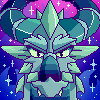
Dragons are omnivores and will eat meat, seafood, fruits, vegetables, fungi, nuts, insects, etc. Some dragons may have a primarily carnivorous diet, while others prefer a vegetarian diet, but most need a mixed diet.
Some monsters in the wild may look like dragons at first glance, but they may actually be completely unrelated to dragons. Creatures that are not dragons but LOOK like dragons are called dragonkin.
By this logic, Daejiin who resemble dragons are considered dragonkin.
For classification purposes, dragons are usually sorted into categories based on their body shape, their element(s), and their skin type. Dragons can fall into any number of these categories at once, and these are not the limit of what is possible!
Click the drop-down menus for illustrated examples of various types of dragons and their abilities!
These are the most common body types found among dragons! Keep in mind that these are just the most common- these are not the ONLY options, and new variations can be found across Ezamire!
QUAD
- Walks on all fours
- Large or small wings
- Capable of wakling on two legs, but is slightly less comfortable that way

A quad dragon. It is of the water and ice elements, and has smooth fish-like scales.
RAPTOR
- Stands on two digitigrade legs with a hunched-over posture
- Large or small wings
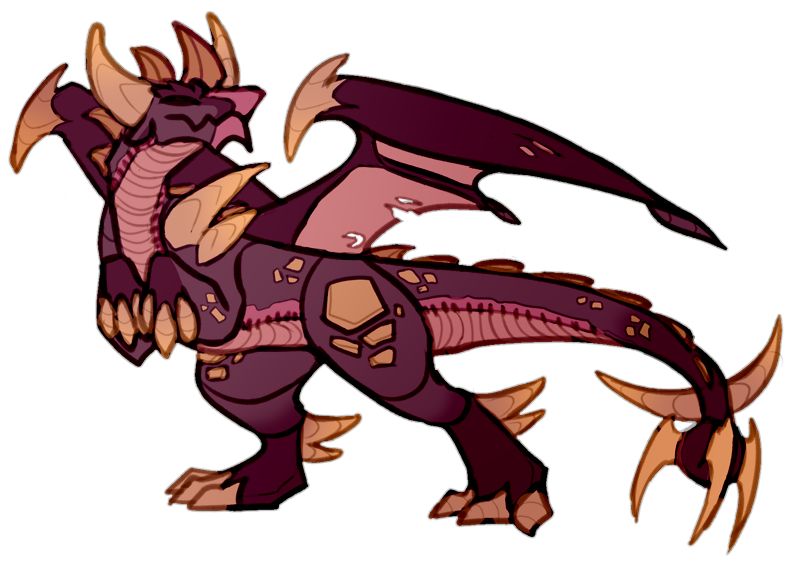
A raptor dragon. It is of the fire and earth elements, and has sharp reptilian plates and scales.
ANTHRO
- Stands upright on two legs, usually digitigrade
- Human-like body shape
- Small or large wings
- Capable of walking on all fours, but slightly less comfortable that way
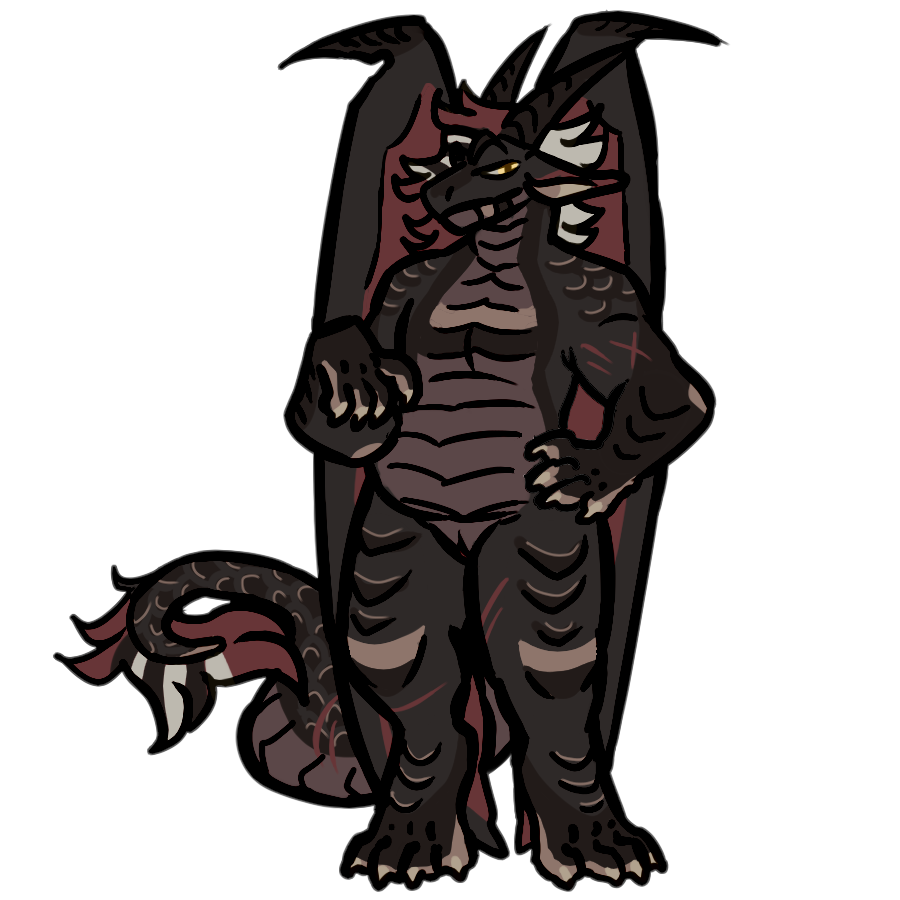
An anthro dragon. It is of the dark element, and has large reptilian scales.
DRAKE
- A quad dragon without wings
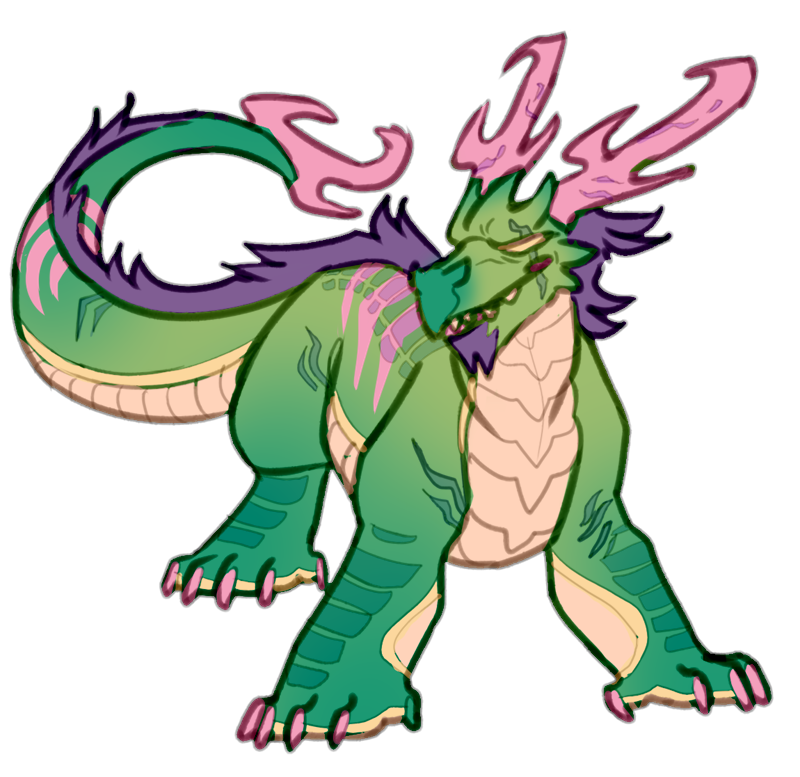
A drake. It is of the nature and earth elements, and has reptilian scales with a furry mane.
TAUR
- Anthro and quad body types combined
- Similar to a centaur, but both halves are dragon
- Can have any size wings, multiple sets of wings, or no wings
- If a taur only has one set of wings, it will always be located on the quad half of the body
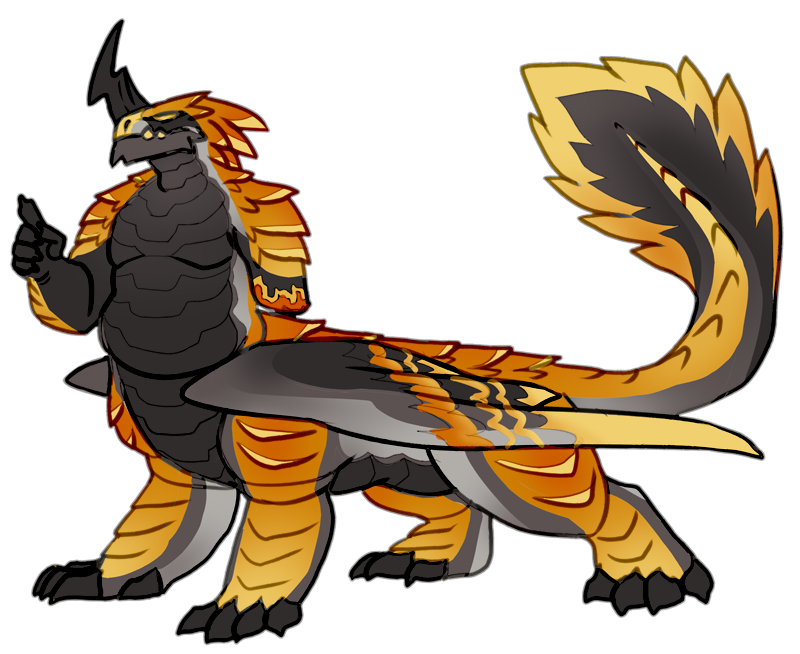
A taur dragon. It is of the electric element, and has heavily armored plating.
HYDRA
- At least two heads; the heads are one "consciousness" rather than separately thinking organisms. The heads will often all speak simultaneously, though muscle training can be done so that a hydra can use each head for different tasks at the same time.
- Any size shape or body
- Any size wings, or no wings

A hydra. Some hydras have heads that focus different elements. In this case, the right head is wind, the middle head is ice, and the left head is fire.
WYVERN
- No arms
- Two digitigrade legs
Large to extremely large wings; the wings are sometimes used to walk, while some other wyverns only walk on their hind legs like birds

A wyvern. It is of the fire and earth elements and primarily uses lava magic, and it has short, downy feathers.
AMPITHERE
- No legs
- Long, snake-like body
-Large to extremely large wings; the body may have snake-like scutes for movement, or the wings may be used in place of legs in some cases
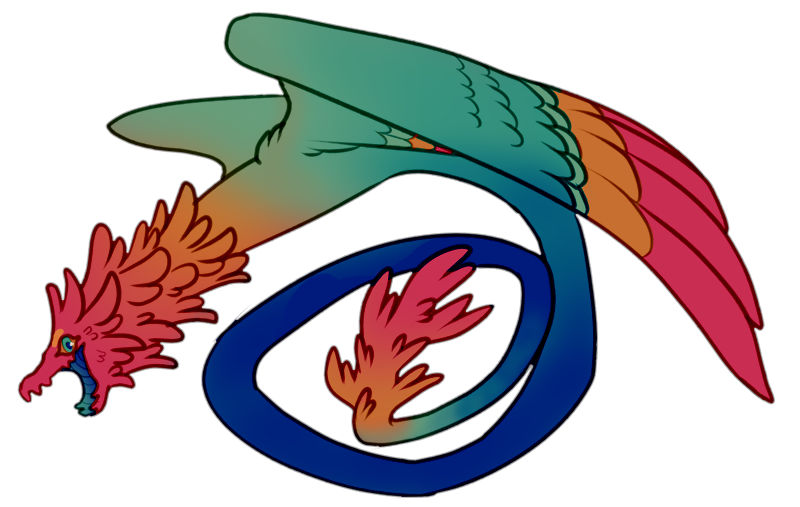
An ampithere. It is of the sound and wing elements, and it has feathers.
LINDWYRM
- Two arms, but no hind legs
- Long, snake-like body
- Any size wings, or no wings
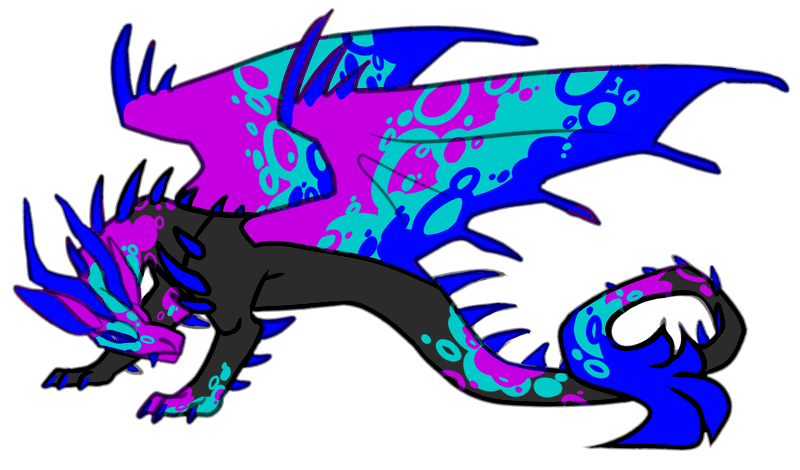
A lindwyrm. It is of the poison element and has smooth sphynx skin, with a coarsely spined tail tip that looks like fur from a distance.
WYRM
- No legs or wings
- Long, snake-like body
- Belly scutes for movement
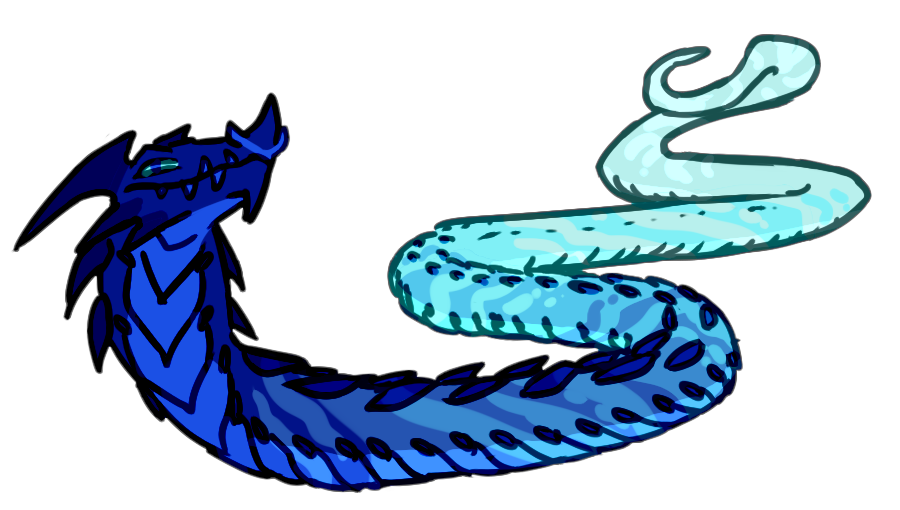
A wyrm. It is of the water element and has small, smooth scales.
FAE
- Vaguely insect-shaped and smaller than 5 ft (1.5 m) in length, often featuring frills and/or antennae
- Large wings, often butterfly or insect-like

A fae dragon. It is of the water element and has tiny smooth scales, as well as heavily tattooed wings.
INSECTOID
- Often has an exoskeleton in addition to internal hollow bones
- Six or more legs
- Insect-like eys, tail, and wings
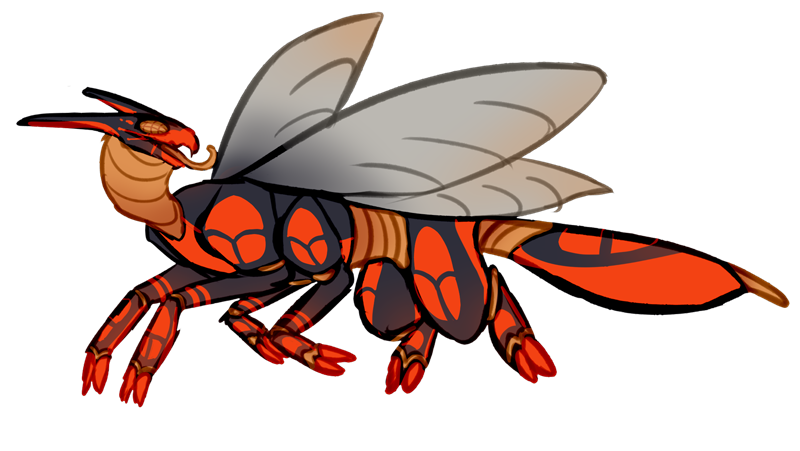
An insectoid dragon. It is of the dark element, and has an exoskeleton.
KAIJU
- More than 100 ft (30 m) in length
- Any size wings, or no wings
- Any number of limbs
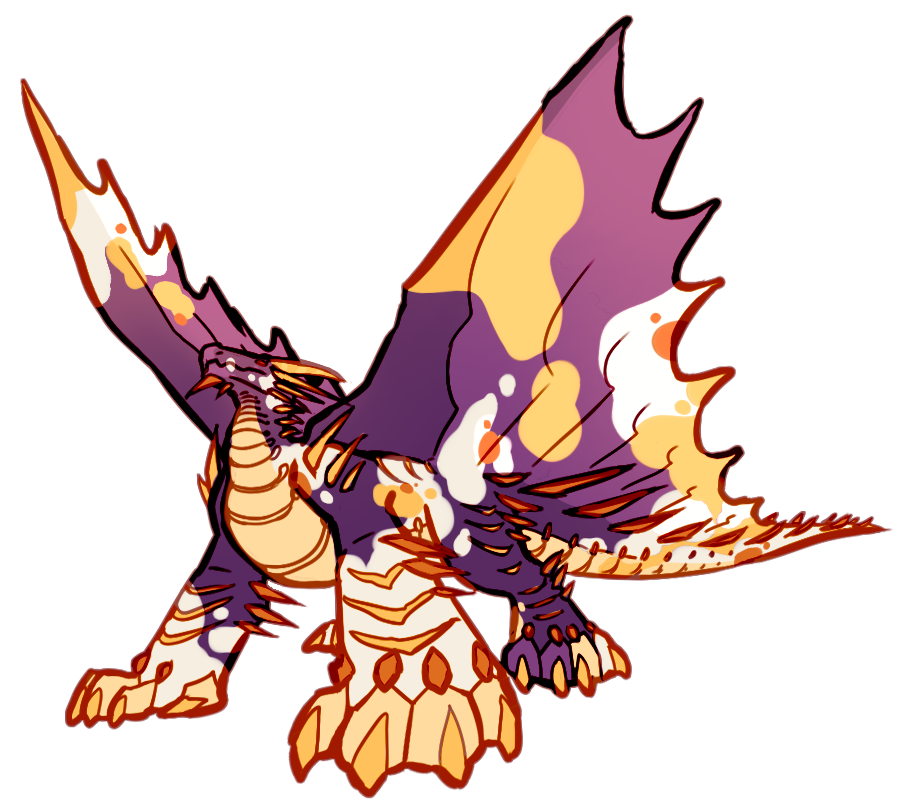
A kaiju dragon. It is of the wind and sound elements, and has smooth fish-like scales.
OTHER
- A very rare body type that does not fit into a mainstream category
- May have extra limbs, mouths, or eyes
- More common in light, dark, and nuclear dragons

A dragon with an "other" body type, with an extra set of arms, wings, three tails, and many eyes. It is a nuclear dragon, and has smooth sphynx skin.

The element of a dragon is the type of magic that it learns most easily. Most dragons have one or two elements, but in rare cases some will have three or four. Elements are inherited genetically, so a dragon with parents with different elements will have a random genetic chance of inheriting either or both elements.
Dragons with multiple elements are born mildly proficient with both elements, while dragons with one element are born VERY proficient with that one element.
Any element can technically be learned by any dragon, but the difficulty increases the more elements one learns. Elements "opposite" of a dragon's innate element are the hardest to learn, while those "similar" to it are fairly easy. For example, fire dragons struggle greatly with water and ice magics.
Elements often, but not always, influence the colors of a dragon. Common colors associated with each element are listed below, as well as that element's strengths and weaknesses. But do keep in mind that strengths and weaknesses are subjective, and a master fire dragon could easily beat a weaker water dragon with the right techniques.
Dragon elements, while very dangerous, aren't as lethal as nonmagical fire, ice, poison, etc. It is very much possible to kill enemies using elemental magic, but most dragons don't train to have that much power, because dragon society teaches that elements are for study, training, self-defense, and performance. However, the war with Malefor caused a lot of dragons to train for the kill.
Dragons can also perform a fury attack once they've fully mastered an element. Fury is a powerful explosive blast that uses a dragon's entire body and energy. These can only be performed very rarely, and are often used as a last resort when overpowered or outnumbered. General fury appearances are described below, but they can be heavily customized by the user, and their appearance may also be influenced by strong emotion.
This is just a general guide and does not encompass EVERYTHING dragons can do with their powers. Elemental abilities are very versatile and customizable, and many dragons develop their own unique fighting style or sub-elements! Feel free to get creative!
FIRE
Common Colors
Red, orange, yellow, cyan, blue, white, magenta, gray, black brown
Common Abilities
Fire breath - A breath of flames; can be any color or shape
Smoke - A breath of concentrated smoke; can disrupt breathing, burn the skin, and/or block vision
Lava manipulation - An ability to breathe lava, or create it by melting the earth around oneself; can stick to enemies, burn them, and then harden around them to weigh them down; often overlaps with the earth element
Fire bomb - An explosive ball of fire that can can shoot additional ash and shrapnel
Comet dash - A powerful ability where the entire body becomes cloaked in fire while charging at an opponent
Fire tail/fire slash - Covering one's tail and/or claws in fire and melee attacking with them; this requires less energy than a full comet dash, but in turn requires more precision
Fire whirl - Powerful fire dragons can create tornadoes of fire that can burn enemies on the ground, while the intense updrafts allow the dragon to take flight quickly
Fury
The temperature around a furying fire dragon will heat up rapidly, and it will be cloaked in a veil of fire that explodes outwards, shooting rounds of fire and ash like a volcano; the temperature in the area can remain exceptionally high for days after the explosion
Strong Against: Ice, nature
Weak Against: Water, wind
Similar To: Electricity, nuclear
Opposite Of: Water, ice

An example of various fire breath attacks.
ELECTRICITY / LIGHTNING / STORM
Common Colors
Yellow, cyan, blue, purple, gray, white, magenta, cyan, black
Common Abilities
Lightning breath - A breath of electricity; can be any color or shape
Ball lightning - Orbs of concentrated electricity that explode on contact with enemies
Sparks - A breath of burning hot electrical sparks; can be explosive at a short range
Summon storm - Masters of electricity can create a storm cloud on the ground that blocks vision and continually strikes enemies with harsh rain, wind, and lightning
Electric whirlwind - A miniature tornado of concentrated electricity can be thrown across the battlefield
Power machinery - Using a weak lightning stream through the mouth or hands, an electric dragon can charge or power on dead machines
Power surge - Sends electricity through the user's feet into metal, water, or any other conductive material, electrifying its surface and anyone standing on it
Fury
A storm cloud forms above the dragon, incredible static builds up, rain and wind begins to pummel enemies, and densely packed bolts of lightning strike the entire surface of the ground; the region may have unusually nasty weather for days after the explosion, and touching conductive materials will result in a nasty shock
Strong Against: Water, ice, wind
Weak Against: Earth
Similar To: Fire, wind
Opposite Of: Earth

An example of various lightning breath attacks.
ICE
Common Colors
White, blue, silver, teal, cyan, pastel colors
Common Abilities
Ice shards - A breath of icicles that can pierce through skin
Snow - A harsh breath of hail, snow, and ice that can push enemies back and slow them down with extreme cold
Ice stream - A steady stream of pure ice that takes more power than snow breath, but is capable of completely freezing enemies in place
Ice bomb - A ball of concentrated ice and snow that explodes on impact
Dry ice stream - Only the most powerful masters of ice are capable of breathing dry ice, which freezes and burns enemies at the same time and is capable of trapping almost anything inside
Ice tail/ice claw - A quick spin or slash; ice layered on top of the tail or claws shatters onto the enemy on impact
Snowball - The dragon rolls down a hill and literally becomes a snowball, capable of crushing large groups of enemies at once
Summon snowstorm - Powerful ice dragons are capable of creating an icy fog, summoning a torrential downfall of snow and hail in a large area of effect
Skating rink - The dragon stomps and freezes the ground so that they can skate, but enemies will likely slip and fall
Ice cube - The dragon freezes itself inside a block of ice as a form of defense; the cold temperature will slowly regenerate its energy
Fury
The ground freezes solid and a cold fog forms, trapping enemies in place as snow, hail, and icicles pour down from the sky; an avalance explodes outwards from the dragon, buring everything in snow; the area can remain snowy for days after the blast
Strong Against: Nature, poison
Weak Against: Fire, electricity
Similar To: Water
Opposite Of: Fire

An example of various ice breath attacks.
EARTH
Common Colors
Green, brown, gray, chartreuse, teal, tan, olive, yellow
Common Abilities
Shockwave - A breath of invisible, black, gray, or green force that knocks enemies back into walls; capable of knocking weak buildings down
Spines - A breath of sharp rocks and debris that can pierce and bother enemies' eyes
Crystal shards - A breath of crystal shards that can pierce enemies and sap their strength; if the crystals are then eaten by the dragon, it can regain energy
Lava manipulation - An ability to breathe lava, or create it by melting the earth around oneself; can stick to enemies, burn them, and then harden around them to weigh them down; often overlaps with the fire element
Earth flail - A ball of concentrated force attached to the dragons meouth; able to be swung around like a flail, and can be slammed into the ground to send out a shockwave
Earthquake - The dragon stomps out a miniature earthquake that topples all enemies and small structures in the area; masters of earth can knock large buildings down
Rock blast - As the dragon slams their hands or tail down, sharp rocks shoot up from the ground below enemies
Crystallize - The dragon traps itself or an ally inside a crystalline structure for protection, or shatter it as an offensive attack; the crystal will regenerate a dragon's strength a little if touchedm, and a lot if eaten
Fury
The earth cracks deeply and quakes in repeated shockwaves around the dragon, and boulders and debris rain from the sky to crush everything below; spines of rock explode upwards from the ground in a massive final blast; causes severe structural damage to populated areas
Sense vibrations - The ability to tell exactly where movement is located through tiny vibrations in the earth; powerful earth dragons can tell the shape, weight, and height of an enemy without ever seeing them
Strong Against: Electricity, wind, sound
Weak Against: Poison
Similar To: Nature
Opposite Of: Wind, electric

An example of various earth breath attacks.
NATURE / LIFE
Common Colors
Green, chartreuse, yellow, brown, cream, white, light blue
Common Abilities
Leaf shards - A breath of sharp, hardened leaves that cut enemies
Pine breath - A breath of pine needles, bark, seeds, and debris that pieces and irritates the skin; can cause itchy rashes
Water stream - The water breath of a nature dragon can either gently heal sounds, or blast away enemies; overlaps with water magic
Flower bomb - A tightly packed ball of flower, pollen, ithcy plants, artificial insects, and other irritatnts that explodes on impact, stinging the enemy and making them cough and sneeze
Vine tongue - A breath of vines shoot from the dragon's throat and grab targets, throwing them around or trapping them
Heal nature - By touching dead plants and deeply focusing, a nature dragon can revive broken stems, dead flowers, and vines; only the most powerful nature masters can heal large trees
Thorn trap - Thorny vines burst from the ground and trip or tie enemies down, capable of restricting movement and/or breathing
Detect/heal pollutants - The ability to identify if food, water, or air is contaminated with poisons or pollutants; powerful nature dragons can purify these and make any plant safe to eat
Fury
A spiraling swarm of leaves, seeds, rocks, water, pollen, sunlight, and artificial stinging insects; gnarled tree roots, thorns, and vines burst from the ground and strangle enemies, sucking out their energy and absorbing it into the roots; trees and massive flowers will sprout, crushing enemies, and the soil in the area will stay soft and fertile for months after the fury, where wildflowers will continue sprouting rapidly
Strong Against: Water
Weak Against: Fire, ice, poison
Similar To: Earth, water
Opposite Of: Poison

An example of various nature breath attacks.
WIND / AIR
Common Colors
White, gray, cyan, teal, blue, lavender, pastel colors
Common Abilities
Gust - A short, intense breath of heavy wind that blasts enemies backwards
Suction - A reverse gust of wind that sucks enemies towards the dragon
Cloud - A breath of thick gray clouds that will stay in the area for awhile and block enemies' vision
Tornado - A powerful whirlwind that varies in size depending on the power of its user; only master wind dragons can summon full size tornadoes, but they must be careful that they do not lose control of the vortex
Pressurize - A downward gust of wind so strong that it can pin creatures to the ground
Steal breath - Sucks the air out of an enemy's body, forcing them to stop moving and breath heavily; can be used to suffocate enemies to death, but this is heavily frowned upon
Sense weather - Powerful wind dragons are capable of sensing weather patterns in far off lands, and sometimes even predicting their movement and development
Fury
A tornado forms around the dragon; winds suck enemies in, spinning them and repeatedly slamming them to the ground before tossing them out violently; this can cause severe structural damage to populated areas, and windstorms may persiste for days after the fury ends
Strong Against: Fire
Weak Against: Earth, electricity
Similar To: Electricity
Opposite Of: Earth

An example of various wind breath attacks.
WATER
Common Colors
Blue, teal, cyan, navy, purple, white, gray, tan
Common Abilities
Water blast - A stream of water breath that can push enemies back or put out fires; the temperature can be made burning hot or ice cold
Steam - A breath of boiling steam that burns enemies
Bubble breath - Useful for catching bugs... maybe?
Gentle stream - A breath of warm, soothing water that can heal wounds; works in conjunction with nature magic
Waterspout - Summon a whirlwind of water that sucks in enemies and thrashes them; varies in size depending on the strength of its user
Tsunami - Water builds up on the dragon's body until it is released in the form of a large wave, blasting away anything in its path
Summon rainstorm - The area fills with dense clouds and fog, hindering vision, and sharp cold rain pours down from the sky
Breathe underwater - Even water dragons without gills are capable of breathing underwater; water magic enables them to absorb oxygen from water passively through their scales
Fury
The area becomes foggy and a tsunami explodes outwards from the dragon, flooding the area; waves continually thrash enemies, destroying everything in their path, as bouts of freezing rain pour down from above; the area can remain flooded for days after the fury ends
Strong Against: Fire
Weak Against: Nature, electricity, poison
Similar To: Ice
Opposite Of: Fire

An example of various water breath attacks.
POISON
Common Colors
Purple, green, brown, black, lavender, magenta, cyan, clashing neon colors
Common Abilities
Toxic Waste - A stream of poisonous acidic breath that melts enemies and leaves them dizzy, temporarily blinded, and/or temporarily paralyzed, depending on the dragon's effect of choice
Poison fang - Venom spat directly from the fangs of a poison dragon that sizzles and melts the flesh of enemies
Dart - A breath of small, dart-like spines taht insects muscular and/or psychological relaxants into enemies, causing them to get high, stumble around, and/or lose control of their movements; can be used recreationally in small doses
Toxic bite/slash - Venom is injected into an enemy through the use of the teeth or claws; the effect varies depending on the individual dragon
Smog - The ability to summon a dark, heavy fog that exhausts enemies, sometimes to the point of making them fall asleep in battle
Scorpion strike - The tip of the tail is coated in venom and jabbed into an enemy's body; the effect varies depending on the individual dragon
Fury
A thick smog followed by a tsunami of poisonous liquid floods the land, and thorns filled with muscle relaxants burst from the flood, ensuring the substance enters the enemy's bloodstream; the area will remain swampy, and breathing in the air here and may cause dizziness and sleepiness for days after the blast
Strong Against: Water, earth, nature
Weak Against: Ice
Similar To: Nuclear
Opposite Of: Nature
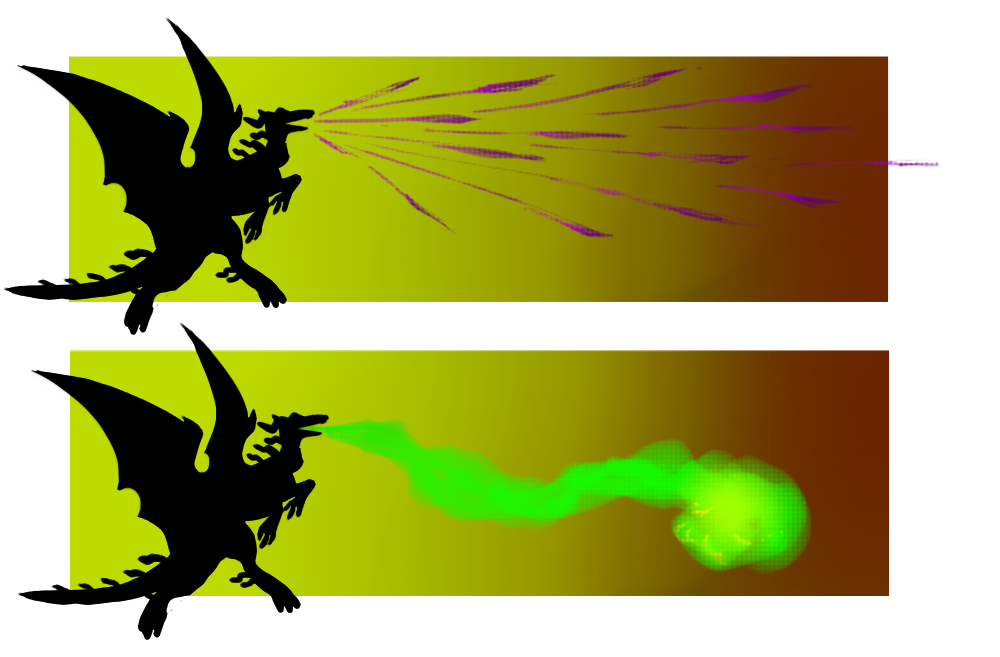
An example of various poison breath attacks.
NUCLEAR
Rare
Nuclear dragon magic doesn't work quite the same way real radiation does. It has a very short half life, lasting only a few days (or a few months for masters of nuclear abilities). Effects of exposure include dizziness and lightheadedness, a strange buzzing sensation, visual and auditory hallucinations, temporary physical anomalies (suddenly growing extra eyes, mouths, or limbs; will disappear after a few days without exposure), loss of sense of direction, and a lingering feeling of paranoia and dread.
Common Colors
Green, black, cyan, magenta, red, yellow, clashing neon colors
Common Abilities
Atomic flame - A radioactive, colorful breath of fire
Gamma burst - A short explosive breath of quickly-vanishing radiation; can burn, confuse, and blast enemies away
Radiation - A breath of invisible radiation that causes anomalous distortion effects on any living being or surface it lands on; while living things will eventually recover from this, it can permanently alter objects and surfaces
Nuclear blast - Concentrated radiation explodes outwards from the dragon's body, forming a miniature mushroom cloud above the battlefield that continues to rain down disorienting clouds of ash
Absorb radiation - Nuclear dragons are capable of absorbing both magical radiation like their own, and real radioactive substances; this can be used to cleanse irradiated areas, and restores energy to the nuclear dragon
Geiger counter - By clicking an extra organ in their throat, nuclear dragons can measure radiation levels in an area
Mutate - Nuclear dragons are the only dragons who are innately capable of mild shapeshifting- they can add additional eyes, mouths, limbs, wings, horns, spikes, etc.; this can be done on purpose to assist in battle, but it can also happen on accident when a nuclear dragon is feeling strong emotions
Fury
Simulates a miniature nuclear explosion with a mushroom cloud and waves of atomic fire and ash, emitting high amounts of radiation in a concentrated area; the area may stay uninhabitable for months after the blast
Strong Against: Nature
Weak Against: Light, dark
Similar To: Poison
Opposite Of: ???

An example of various nuclear breath attacks.
LIGHT
Rare
Common Colors
White, light colors, yellow, cyan, lavender, light gray, pink
Common Abilities
Heat lamp - A hot, searing beam of light breath that temporarily blinds and burns enemies
Flashlight - A cool or warm beam of light emitted from the mouth, mostly useful for seeing in the dark
Glass shards - A breath of crystalline glass shards that reflect burning hot light and explode on impact
Illusion - The ability to bend light to create the illusion of multiple selves, a misplaced wall, or a trap; powerful enough light dragons can create illusions resembling almost anything
Mind reading - ILLEGAL TO USE; the ability to catch snippets of thoughts and images from the minds of others; whoever's mind is being read will experience a tingly feeling in their head and the sensation that they are being watched; masters of light are able to bypass this and read the deepest parts of your mind completely undetected, but this is considered deeply wrong under any circumstances
Glass field - When a light dragon slams their hands or tail on the ground, massive shards of glass shoot up from the ground underneath enemies, trapping or impaling them
Angel form - The dragon becomes solid light for a moment, allowing them to move through solid walls or dodge incoming attacks
Fury
A sudden blast of light so bright and hot that it can blind enemies for days, causing them to see nothing but white and faint frightening visions; shards of glass rain down from the sky, and horriffic illusions can be seen even through the blindness; the area will stay unnaturally bright for days after the explosion
Strong Against: Dark, nuclear
Weak Against: ???
Similar To: ???
Opposite Of: Dark

An example of various light breath attacks.
DARK
Rare
Common Colors
Black, gray, brown, red, purple, dark deep colors
Common Abilities
Void breath - A burning cold breath like the void; absorbs all light and temporarily blocks vision an disorients the enemy, inducing a strange feeling in the legs as though you were falling through the void
Shadow fire - A black fire that feels like clawed hands grabbing and crawling on the skin
Shadow cloak - Temporarily become a shadow and walk through solid walls and evade attacks
Invisibility - Become almost invisible, with only a slight spacial distortion to denote your presence; only the most powerful dark dragons are able to become completely invisible and inaudible with no distortion
Mind control - When a light dragon slams their hands or tail on the ground, massive shards of glass shoot up from the ground underneath enemies, trapping or impaling them
Nether - A corrupted version of the aether/cosmic beam, learnable only by the most powerful dark dragons, or by aether dragons who have turned to daekness; tears apart enemies by their atoms, vaporizing them completely if necessary
Fury
A sudden blast of light so bright and hot that it can blind enemies for days, causing them to see nothing but white and faint frightening visions; shards of glass rain down from the sky, and horriffic illusions can be seen even through the blindness; the area will stay unnaturally bright for days after the explosion
Strong Against: Nuclear
Weak Against: Light
Similar To: ???
Opposite Of: Light

An example of various dark breath attacks.
SOUND
Rare
Common Colors
All colors and patterns are equally common
Common Abilities
Siren scream - A high-pitched screech that temporarily deafens and/or paralyzes enemies, pushing them away from the user
Sonic burst - A breath of sharp spines of solid, glass-like sound that explode on impact, emitting horrific noises and piercing the skin
Mimic - The ability to mimic the voice or any person or creature the user has heard before, as well as mimicing noises and sound effects
Soundwave - The sound dragon slams the ground, sending out a shockwave of deep, rumbling sound that shatters any delicate materials in its path and blasts enemies backwards
Dog whistle - Ability to hear and speak in extremely high pitched noises; enables secret communication that only other sound dragons can hear
Perfect pitch - Sound dragons are extremely attuned to singing, dance, and playing instruments; they will often learn these skills at professional levels with very little practice
Distort - An extremely specific frequency of sound causes the eyeballs of other creatures to vibrate- this causes hallucinations and other strange quirks in vision that can disorient and frighten others
Fury
A horrifying scream will fill the area, causing dizziness, disorientation, and eventaully deafness that can last for weeks. Solid glass sound rains down from the sky and pins enemies down, stabbing them into the ground so they can't escape. Anyone who enters the area will experience auditory hallucinations for months after the blast.
Strong Against: Wind
Weak Against: Water, earth
Similar To: ???
Opposite Of: ???

An example of various sound breath attacks.
AETHER
Aether dragons are the only dragons who can fully master every element, in addition to their own unique set of powers that they unlock after mastering the other elements. Assume aether dragons can use any ability listed under any of the elements in addition to this list.
Common Colors
MUST be purple (they can have other colors accenting the body, but the main color must be purple)
Common Abilities
Cosmic fire - An impossibly cold, otherworldly purple flame
Cosmic ice - A breath of burning hot violet ice
Cosmic lightning - A black-violent lightning bolt that petrifies enemies and is capable of turning them to stone
Meteorite - An explosive breath of violet space rocks and debris resembling comics
Ferrofluid - A breath of heavy, dark liquid that engulfs enemies, sticking to them and weighing them down
Black hole - Creates a black hole that sucks enemies in and spits them out miles away; useful for escaping tough battles
Dragon time - Speeds up the brain's perception of reality, so that time appears to be moving slower; this allows aether dragons to predict their enemy's next move almost before it happens, but this ability can only be used in short bursts
Telekinesis - The ability to move objects with the mind
Aether breath/fury breath - The most powerful breath; a purple beam of raw energy that tears enemies apart on an atomic level; can also heal severe wounds be reconstructing the flesh
Worldbuilding - Uses an unfathomable amount of energy to move, create, or destroy matter, up to the size of entire planets; can only be used in the event of a worldwide catastrophe, it uses so much energy that the dragon will not be able to use its powers for multiple years afterward (Spyro uses this ability to reconstruct the world at the end of Dawn of the Dragon)
Fury
A horrifying scream will fill the area, causing dizziness, disorientation, and eventaully deafness that can last for weeks. Solid glass sound rains down from the sky and pins enemies down, stabbing them into the ground so they can't escape. Anyone who enters the area will experience auditory hallucinations for months after the blast.
Strong Against: Everything
Weak Against: Nothing
Similar To: ???
Opposite Of: ???
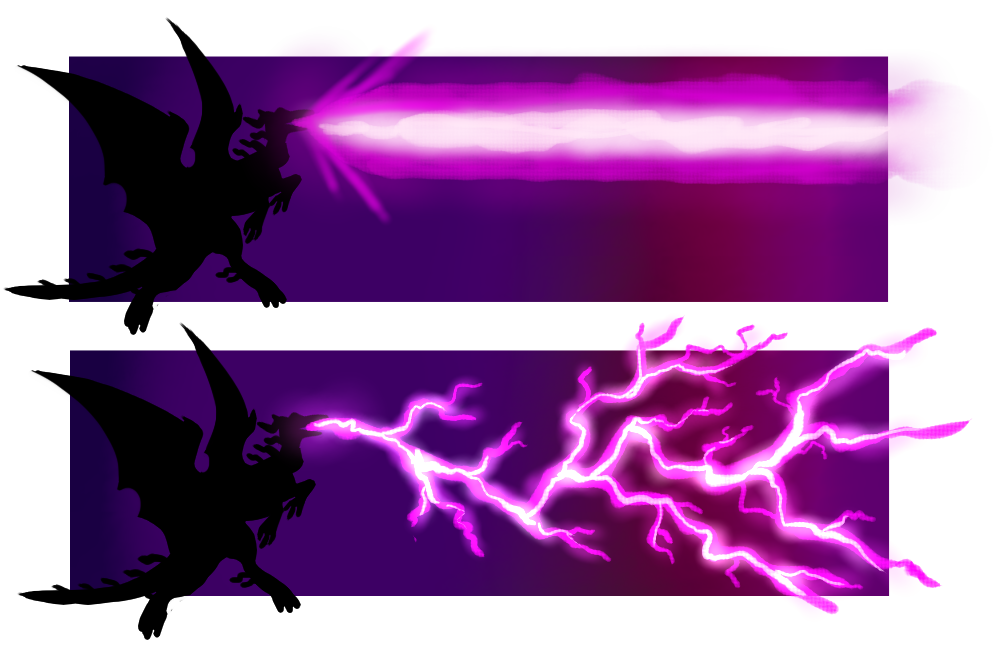
An example of various aether breath attacks.

Some dragons may fall into multiple skin type categories, such as a dragon with both scales and feathers.
Most dragons have at least one set of horns, a crest of some sort running down their spine, a protective plate along their chest and belly, and claws, but not always! (These traits do not affect the skin category of a dragon.)
REPTILIAN SCALES
-Basic flat, bumpy, or spiny scales
-Smooth or rough texture
-Shiny or matte

An example of reptilian scales
FISH SCALES
-Smooth, slippery scales
-May have a slimy texture, or may need to moisturize or bathe regularly
-Often has fins and/or gills
-May shimmer or be iridescent, metallic, or mirror-like

An example of fish scales
AMPHIBIAN SKIN
-Smooth, slippery skin
-Slimy when wet
-Can be matte, shiny, bumpy, or transparent
-Often have fins and/or gills

An example of amphibian skin
SHORT-HAIRED
-Short fur with a rough, smooth, or soft fur texture
-Can be straight, curly, kinky, any hair texture
-May have other mamalian traits like visible ears or a mammalian nose

An example of short-haired fur
LONG-HAIRED
-Long fur with a rough, smooth, or soft texture
-Can be straight, curly, kinky, any hair texture
-May have other mammalian traits like visible ears or a mammalian nose

An example of long-haired fur
WOOLY
-Thick, curly or kinky fur that grows constantly and needs sheared regularly
-Soft or rough texture
-May have other mammalian traits like visible ears or a mammalian nose

An example of wool
HEAVILY ARMORED SCALES
-Plated with thick, smooth, or spiny armor that adds significant weight to the dragon
-Some have cracks between their armor plates that glow with bioluminescence
-Can be matte, shiny, refelctive, metallic, etc.

An example of heavily armored scales
OBJECT PLATED
-Scales are replaced by shaped plates resembling armor, tree bark, glass, crystals, or some other object
-Can be shiny, iridescent, reflective, or matte

An example of object plated
EXOSKELETON
-A hard plating that covers the entire dragon, with only a few areas of exposed skin at the joints to allow movement
-Dragons with an exoskeleton have very few or no internal bones

An example of an exoskeleton
SPHYNX
-Soft, human-like skin devoid of any scales, feathers, or plates
-Often have rough patches, blemishes, acne, and skin conditions like eczema
-Can be smooth or wrinkly

An example of sphynx skin


Dragons are largely reptilian in bodily function, although there are some that lean more towards avian or mammalian traits.
Dragons can identify as male or female, but also have various identities outside the binary that are readily accepted in society. Magic-induced physical gender transition is available to all who want it, but many transgender dragons are happy with the body they were born into. Masculinity and femininity are not ascribed to specific genders, so dragons of any gender can present however they wish.
Dragons have a fairly typical set of internal organs as expected for a large reptilian beast, but with a few notable differences. Dragons need very large lungs in order to practice breath magic, thus the ribcage must be very thick and sturdy to protect the organs inside. Large lungs also allow dragons to breathe while flying at high elevations, and hold their breath underwater for long periods of time.
Dragons have color vision equivalent to that of a human's (with cones for red, green, and blue), and a powerful sense of smell for tracking prey while in flight. Dragons with large, visible ears have much better hearing than those who do not.
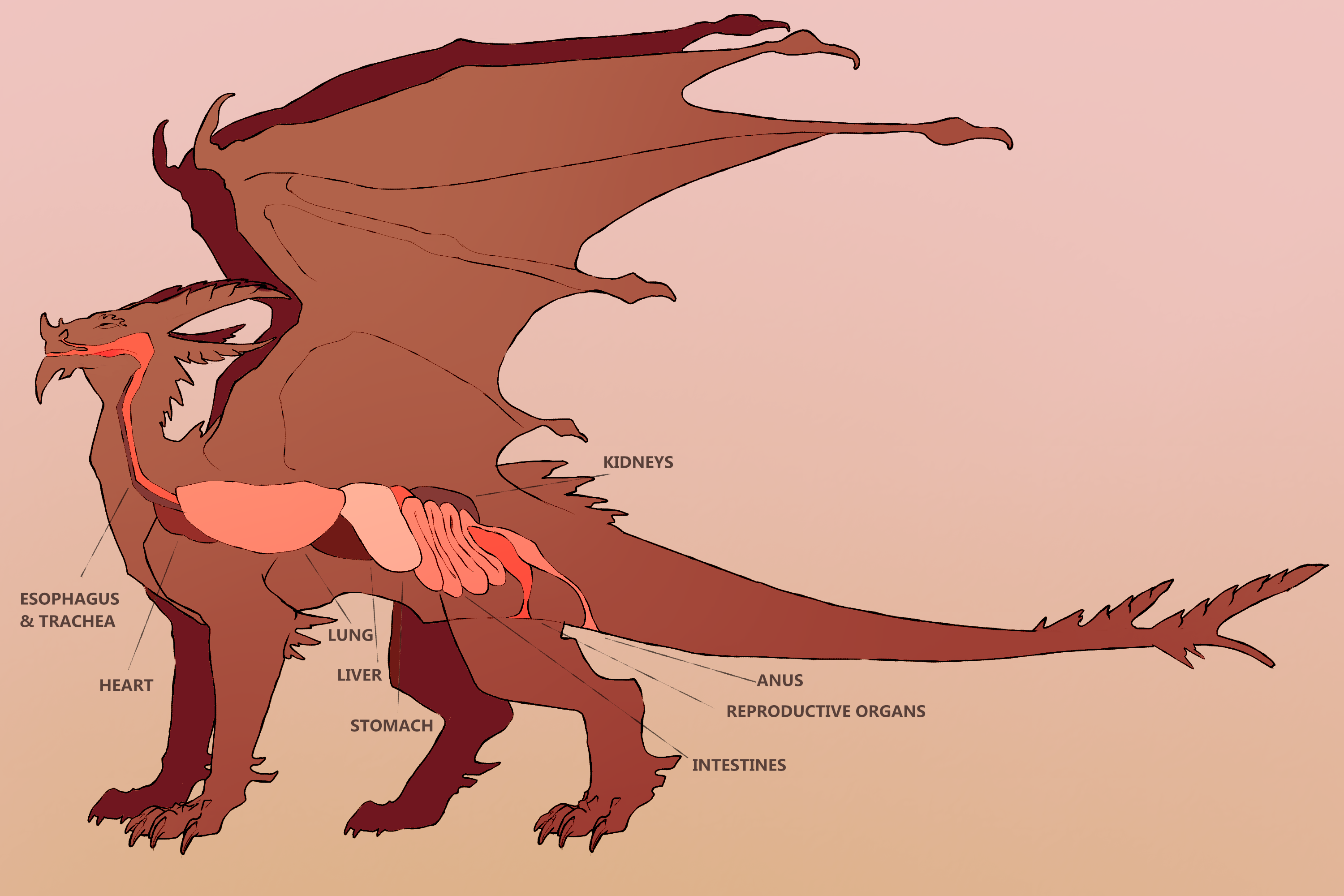
A simplified diagram of a typical dragon's internals. While this diagram is largely reptilian or avian anatomy, it is possible for more mammalian dragons to have warmer blood, fur or wool, visible ears, nipples, or other traits typically only found on mammals. It is also possible for more aquatic dragons to have gills in addition to lungs.
Dragons have a second set of vein-like structures that transport mana throughout their body. Most of these veins culminate around the mouth, as breaths are the most powerful and common form of dragon magic. If a dragon is cut near the mouth, they will bleed both blood and liquid mana, which appears transparent with an opalescent sheen.
Mana will replenish slowly over time, but crystals may be eaten to regenerate it very quickly. Certain types of crystals also cause different moods and physical side effects. Crystals are seen as a sacred object due to their replenishing abilities, and are often used in spiritual practices.
In order to digest crystals, dragon teeth and digestive tract are extremely tough and resilient, and cannot be cut by sharp edges. Many dragons eat rocks, minerals, and crystals for many different reasons; for fun, to stim, or to regain mana or experience various other effects caused by certain specialized types of crystals.
Dragon skin is generally capable of resisting to its own element. For example, fire dragons have skin more accustomed to tolerating heat. This will not make them totally immune to burns, but more difficult to burn.

Dragon genetics allow for extremely varied appearances, much more so than any other creature in Ezamire. The genes follow rules vaguely similar to genetics in our universe, where traits from the parents, grandparents, great grandparents, and (extremely rarely) great great grandparents can be passed on to the child. The chances of certain traits being passed on is also influenced by its interaction with other traits.
The general behavior of elemental skill through genetics is illustrated in the chart below.
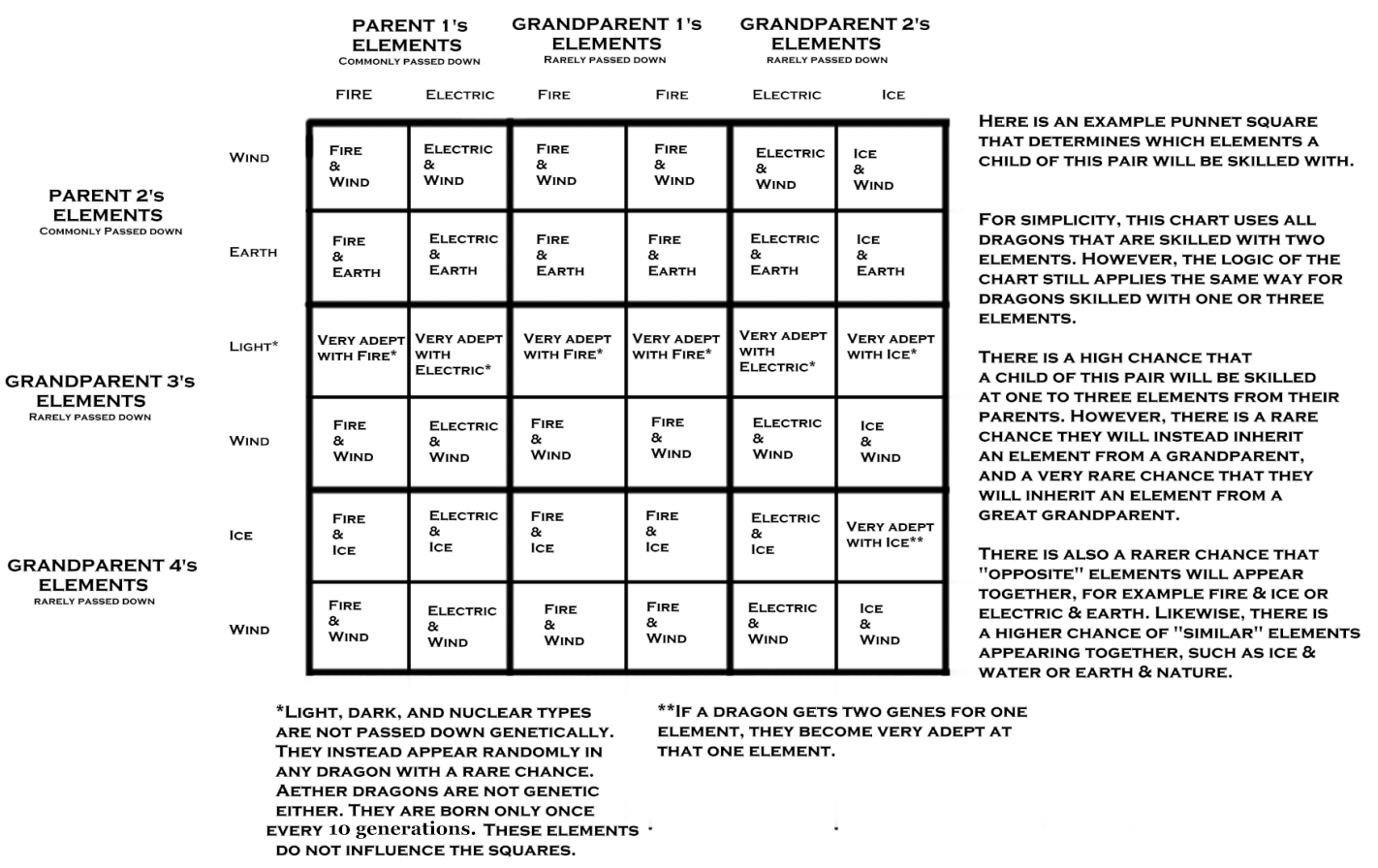
Horn shapes, number of horns, and the placement of the horns follow a similar inheritability to elements. The horns of a dragon will look like a blend of their predecessors' horns.
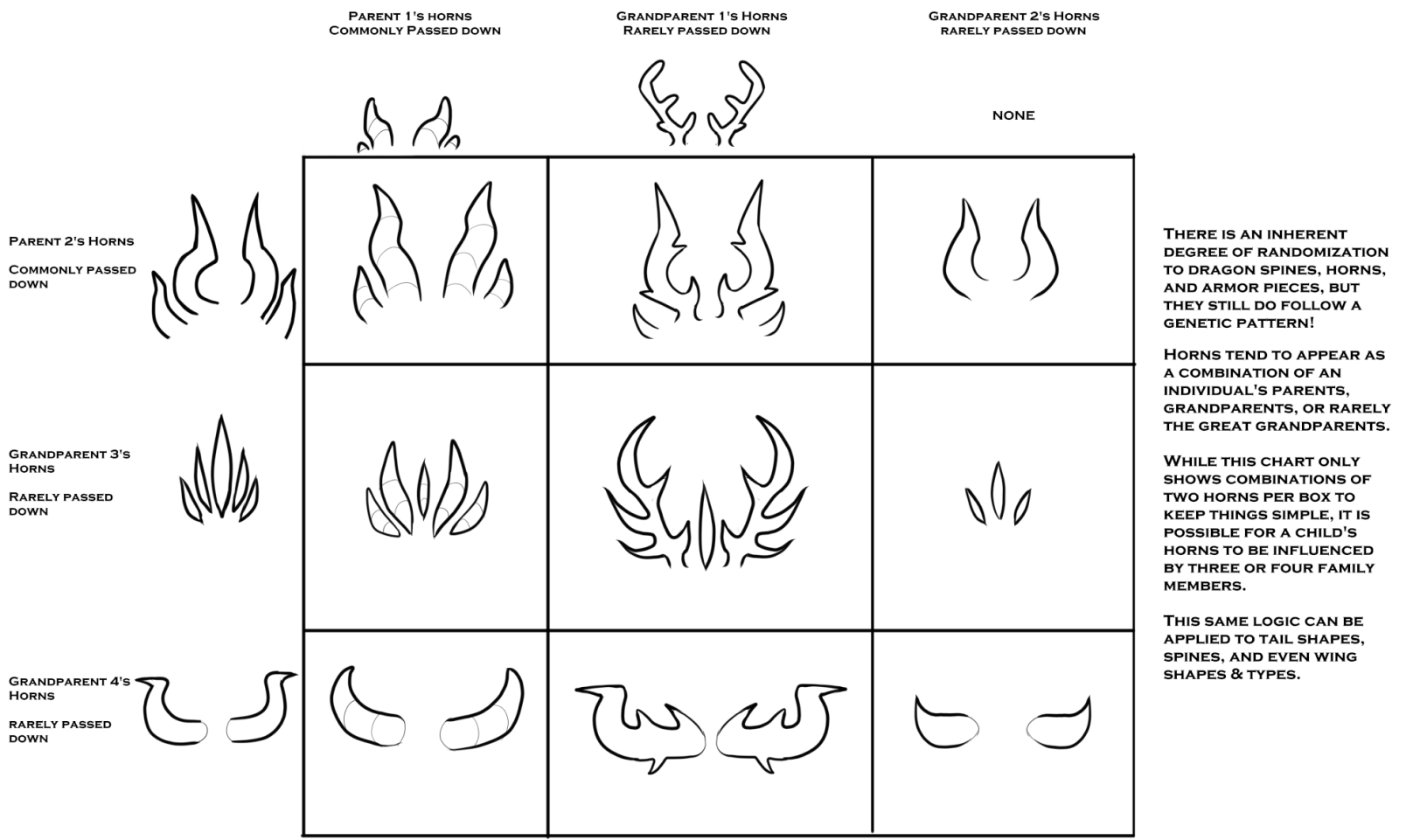

Dragons are social and tend to live in large cities.
This means dragons tend to have a healthy relationship with other sapient species. Dragons offer transportation, magical teachings, and protection to anybody wililng to ally with them.
Some dragons are monogamous while others are polyamorous. Some prefer casual relationships while others prefer long-term. As dragons are found all over the universe of Ezamire, they can adapt to many different cultures and have heavily varying views on friendship and romance.
Older dragon speech patterns often seem overdramatic to other species. Some elderly dragons speak almost exclusively in hyperbole and prophecy. This phenomena is far less common in younger dragons, but they do sometimes word regular sentences in ominous ways.
The written language of dragons is made up of symbology that is simultaneously sharp and round.
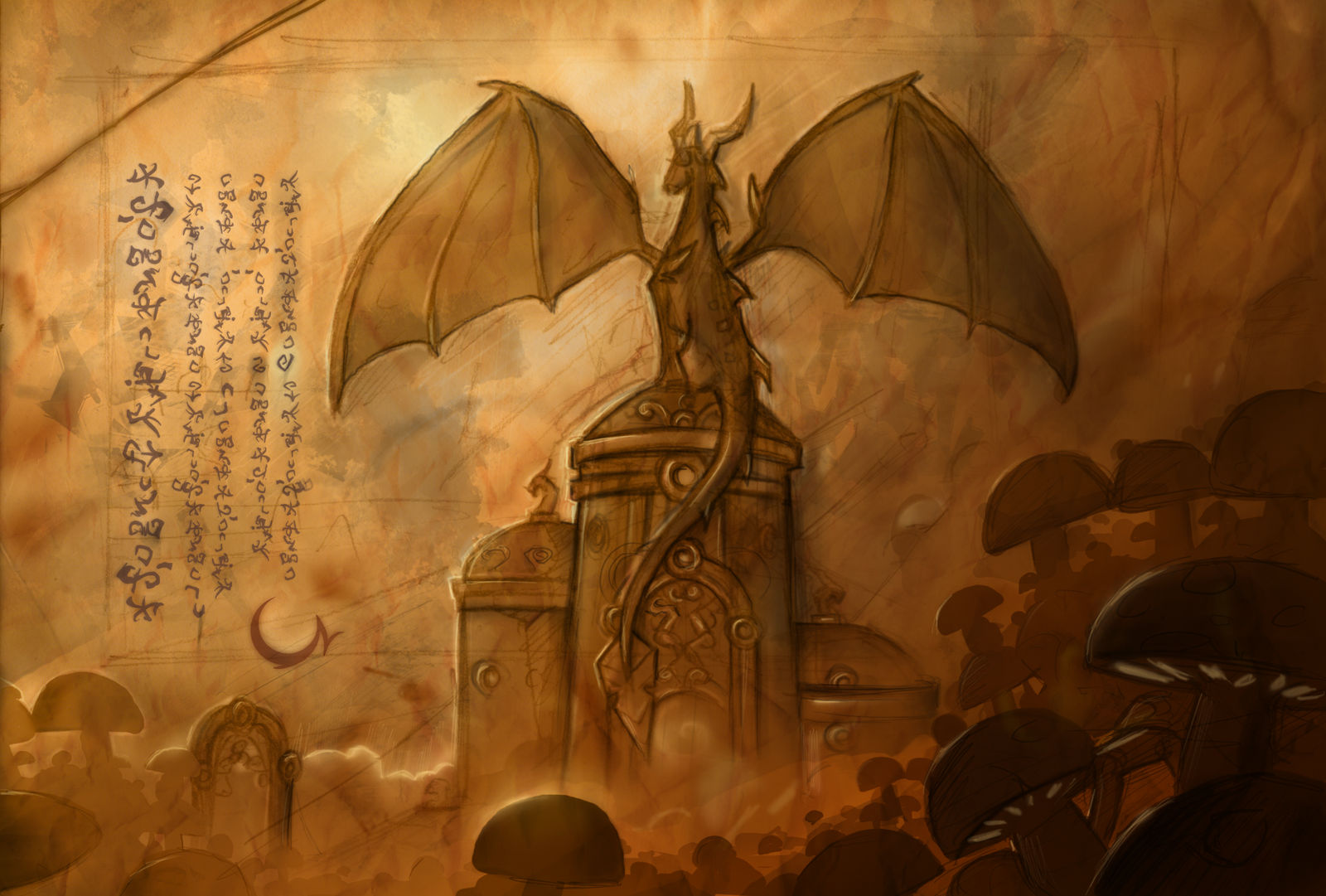
An example of dragon script pictured next to a massive aether dragon, illustrated by Jared Pullen.
In post-war dragon society, dragons are slowly re-learning how to enjoy artwork, relaxation, and luxury. Psychology and counseling are increasingly popular fields as citizens overcome the trauma and fear of the Cataclysm.
While most dragons don't wear any sort of clothing and nudity is acceptable pretty much everywhere, accessories are very popular and are often handmade! Scarves, cuffs, scale/fur dye, piercings, jewelry, and horn/spine painting are among the most common choices. Scale dye (or tattoos on areas of exposed skin) is also somewhat common.
In the post-war world, armor has become fashionable and is often worn for show or for battle training, sometimes even as an everyday outfit.
Dragon hatchlings are raised communally in temples by "Guardians", in which there is one temple per city, and one Guardian per common dragon element. Guardians are elders who are masters of a particular element. It is very common for the Guardians in a particular city to be in a polyamorous relationship, but this is not always the case. Guardians raise the town's children and train them in elemental magic until they are capable of flight and self-defense (usually after twelve to fifteen years). After this, the tweenage dragons are allowed to venture out into the world to learn and gather new experiences.
Dragons measure time in seasons and ages. One cycle through spring, summer, fall, and winter constitutes a year, with the beginning of each year falling on the first day of spring. Ages are declared when a massive historical event takes place, which means the amount of time in each age varies greatly. The start of the war with Malefor was a new age, and an even newer age just began recently, when Spyro stopped the Cataclysm and repaired the planet.
A period of time can also be measured by the positioning of the two celestial moons, Zella and Adrano, with each period starting at an eclipse, or the "Night of Eternal Darkness". But this method is difficult to master without measuring tools, and the night of eternal darkness is feared by most citizens, which is discussed further in the mythology section.

For humans, gender is a large facet of one's identity, varying across cultures, often influencing style of dress, behavior and presentation, interests, and role in relationships, though this depends greatly on the individual. For dragons, element fills this societal role rather than gender. A dragon's gender is seen as less important and more of a personal matter, while one's element is something celebrated loudly across the realms!
A dragon's element(s) can influence their preference in food, accessories and style, interests, behaviors, and of course their appearance and magical abilities.
Tens of thousands of years ago, the only four recognized elements were wind, water, earth, and fire. Fire dragons generally lived near the equator, water dragons in bodies of water, earth dragons in valleys and caves, and wind dragons high up in the mountains. Though they interacted and recognized each other as one species, their cultures were very distinct and did not always see eye to eye.
Large cities were built in places that were accessible to all four elements, but a problem arose; wind dragons began to realize that not all of them were the same. Some wind dragons specialized in lightning rather than wind, and through a vote multiple cities declared lightning its own separate element. Lightning was just the first of many new elements added to the table.
As contact with the polar regions of the dragon realms were eventually established, ice dragons were discovered and ice was declared a new element. Despite ice and liquid water being the same basic material, ice and water dragons are often distinct in appearance, behavior, and ability.
Some earth dragons began to specialize in soil, rock, metal, sand, and crystal, while other earth dragons began to specialize in the natural world, plants, flowers, healing, and sunlight. Thus, nature and earth were declared two separate elements.
Many centuries go by, until a few thousand years ago, poison dragons are discovered living in a few tucked away swamps across the realms. Initially, there was hesitation about poison as a new element; all the previous new elements had been branches off pre-existing elements, but poison was not that. Declaring poison an element meant accepting that elemental abilities far outside the norm could come to be. Still, it was only fair that poison was declared a new element. Societal fear of stranger and more powerful elements begins to heighten.
And this trend would surely continue; light and dark dragons are discovered shortly after poison dragons. Strangely, light and dark dragons appear to be random rare mutations. The fact that they do not seem to follow genetic logic baffles elemental experts, but still, light and dark are declared new elements.
Just one thousand years ago, the first nuclear dragon was born. Her fire caused unusual effects such as temporary mutations, buzzing sounds, hallucinations, lightheadedness, and confusion, and her strange many-limbed appearance stuck out easily in a crowd. It was clear she was the first of a new kind of random mutation, and she herself declared nuclear magic a new element. She still lives, though she is frail with old age. Her and her children became the first masters of nuclear magic among dragonkind, and she is still seen as a hero and symbolic mother figure to most nuclear dragons today.
Many more centuries go by, and elemental historians become certain that there are no more new elements to be discovered. However, they would be proven wrong when just two hundred years ago, the first sound dragons were discovered. With poorer eyesight but incredible hearing and sound-manipulating magic, the five sound dragon children were born to a group of earth dragons who had lived underground for an incredibly long time. Whether this was an impossibly fast adaptation to their environment or a random genetic mutation is unknown, but sound was quickly declared a new element.
One dragon seems to have singlehandedly created plasma magic. This information has not yet been made public, so the element has not yet been declared.
Much of the history of aether dragons has been lost (or, as many historians suspect, purposefully unwritten). Their exact point of discovery is unknown. Some claim there has always been an aether dragon born once every ten generations, while others claim Malefor was the very first of his kind.
Dragons often create artworks, buildings, or even theme cities after one or multiple elements. Particular elements tend to have certain colors and styles associated with them, but architecture also varies by region. For example, temperate and warm areas are likely to have open-walled buildings, while colder locations will have more enclosed spaces to keep warmth in.
FIRE: Fire architecture often includes dark paths, grays and blacks accented by hot reds, oranges, yellows, and cyans. Brick and stone are utilized commonly, while wood and other flammable materials are strictly avoided. Though in the modern day, it is common for all large cities to avoid wood as much as possible to be inclusive of those with a fiery sneeze.
ELECTRICITY: Sharp, jagged, geometric edges on buildings and pathways. Marble and smooth stones that look crackled with forking patterns. Fractal burnt wood is often used as a decorative accent as furniture or hung on walls. As electric dragons are more likely to live in places with severe weather, tall buildings equip lightning rods which store electrical energy for use by dragons, and buildings must be strong enough to withstand tornado conditions.
WATER: Cities built partially underwater, or in areas that flood easily. Tables and decor are generally bolted to the floor to prevent them from being washed away during storms. Water dragons love spiralling or wave-like patterns, tropical aesthetics, domed rooves, arches, and aquariums.
ICE: Ice dragons in the arctic regions build for warmth and tend to have very closed-off, dome-like buildings with a campfire or other heat source in the center. They often build from the ice they breathe, with specific ice architects mastering the ability to breathe buildings into reality incredibly quickly. This also means that ice dragon buildings can be easily moved or rebuilt. Outside the arctic regions, ice dragon community buildings tend to have floors of solid ice kept frozen by magic fields so that they have a cold surface to walk on.
EARTH: Earth dragons often live partially underground, expanding downwards rather than upwards. They're also likely to build directly into mountainsides and mesa plateaus, often utilizing clay strata for beautiful striping effects of rusty reds, burnt oranges, and various shades of brown and black. While other dragons may find it unsanitary, earth dragons love raw mud and soil in between their toes and will not usually build solid floors.
NATURE: Nature dragons love building civilizations among the trees. They do prefer wood as a building material, which can cause fire dragons some anxiety while visiting. Nature dragons excel in using bridges to connect buildings placed expertly around or through trees, being incredibly careful not to disrupt or harm any more trees than are necessary for building. Buildings are often cloaked in lichen, moss, vines, and ivy, and they often agree with earth dragons that the best kind of flooring is just raw grass and soil. Waterfalls, ponds, streams, and rock formations are often found near nature settlements as both natural resources and decorations.
WIND: Wind dragon architecture often features high-angled shingled roofs with curling ends atop incredibly tall buildings, featuring balconies high up in the sky. Neutral teals, reds, and whites are common, as are swirling patterned decorations and spiral staircases. Wind-centric cities are often built in the wide open plains with plenty of room to soar, and flight obstacle courses are a common sight to behold.
POISON: The first poison-centric cities were built in toxic swamps, often out of whatever is nearby. The first poison dragons prided themselves on using whatever they could find around them; swamp trees for wood, stone for foundations, and incredibly simple building plans. Today, poison dragons are associated with a more brutalist style of architecture.
Because light, dark, and nuclear dragons are random mutations rather than genetically passed down, they don't have as central a style as the other elements do yet. Sound dragons, being brand new, are in the same boat. Given more time and room to put their stamp on society, they are likely to further develop their own individual styles.
FIRE: Making food as spicy as possible for fun and bragging about how much heat you can handle; fire dragons have a naturally higher spice tolerance and may eat food that would be offensive to other dragons! While all dragons can consume charcoal to counteract any poisons they accidentally consume, fire dragons in particular love to eat coal, ash, and charred wood for fun.
ELECTRICITY: Statically charged bits of minerals included in meals that will give you small zaps as you eat; like spicy food but weirder and more niche, many electric dragons claim it feels good! Will often cook meats using electricity to get a blackened result.
WATER: Eat large amounts of seafood, as they usually live in or close to water. Will commonly wrap meals in seaweed for easy handling! Will also prepare and eat certain corals, sometimes chewing on them dried alongside minerals.
ICE: Dry ice is used to give food a smoky effect. Will sometimes freeze drinks into solid format and chew them, rather than drinking them the traditional way. Ice dragons love fatty meats and tend to use more oil in their meals.
EARTH: Earth dragons are EXPERTS in the niche types of rocks, crystals, and minerals, and will often discover more specific types of minerals that work better for certain elements, have physical or emotional healing properties, and even cause other weird effects. These are usually added to meals as part of the experience!
NATURE: Tend to overseason their food using complicated combinations of herbs, which are raised and bred to maximize taste. Since master nature dragons can will plants to grow incredibly quickly, they can grow fruits, vegetables, nuts, seeds, and herbs instantly, harvesting them at exactly the right ripeness. Nature dragons also engineered many of the best soups and stews!
WIND: Tend to eat a lot of birds and other airborne creatures, as they often hunt in flight! Wind dragons are capable of catching flying creatures so fast that few other dragons can do it, and these rare meats are considered delicacies!
POISON: Your entire meal is an edible of just the right strength, with euphoric drugs made from refined poison dragon venom laced into it. These types of meals are served at adults-only restaurants with safety parameters in place. Poison dragons are also immune to most poisons and will eat fungi and plants that could kill anyone else.
LIGHT: Light dragons will sometimes cast illusion magic on food to make it look artistic and colorful! They are also attracted to glowing foods such as bioluminescent fruits and mushrooms, and will often work with water dragons to seek bioluminescent goods from the deep sea.
DARK: Everything black! Blackened meats and grilled veggies, dyed black desserts with raspberry fillings that look like they're bleeding when you cut them open. Dark dragons love everything gothic and macabre! Dark dragons will often crack open and eat entire bones.
NUCLEAR: Food that crackles and sizzles in your mouth like the dragon equivalent of pop rocks! This effect is often added to fruits as a dessert, sometimes to prank unsuspecting friends. Nuclear dragons love foods that have to be popped or cracked open, and are also more likely to eat meat as soon as it has been caught, sometimes without even cooking or preparing it all the way. Raw restaurants still exist across the dragon realms, as the majority of dragons can still handle raw meat.
SOUND: Sound dragons love the thrill of the hunt almost more than they do the satisfaction of a meal. They will often catch their own food and bring it to restaurants to have it prepared by professionals. Nuts, seeds, crunchy, and popping foods are also incredibly popular with sound dragons due to how loud they are to prepare and eat. While most individuals would focus on taste and texture, sound dragons also appreciate the sound that foods make while being cooked or eaten.
Keep in mind that these are just trends started by dragons of each element; individual preferences will vary greatly!

Dragons are very spiritual creatures, and most hold the belief that their ancient ancestors serve as their spiritual guardians throughout life.
Not much is known about how the ancestors actually lived, due to previous Cataclysms brought on by past aether dragons. Though most dragons do not actually realize these were Cataclysms- from their perspective, it just seemed like a massive set of natural disasters happening all at once.
Much of written history before past Cataclysms has been lost to everyone except for the Chronicler. However, it is commonly believed that the oldest of the ancestors were supermassive prehistoric dragons who mastered powerful magics that modern dragons cannot even fathom. Some scientists hypothesize that most dragons used to have abilities akin to those of aether dragons, and that modern dragon elements are just different "branches" that split off the evolutionary tree over time. Most dragons believe ancestors from all generations still watch over the dragon world today, and can even influence it on occasion, such as in the case of Ignitus's spirit sealing corrupt aether dragon Malefor into the core of the planet. All dead dragons are considered "ancestors" capable of influencing the world, even modern dragons who died very recently. Thus, death is not always seen as a frightening thing, but as the beginning of a new era for oneself.
Dragons who are especially spiritual often attribute instinctual abilities to the ancestors, such as flight, breath magic, and even love. Dragons are sometimes capable of learning new abilities in life-or-death situations, such as a hatchling suddenly learning how to fly after being knocked off a cliff. A religious dragon will thank the ancestors for this miracle.
The mining and eating of crystals is an extremely spiritual experience for most dragons, and
Dragons on the home-planet celebrate a brand new religious holiday, which is the day that Spyro stopped the Cataclysm and repaired the world. While some spend this day contemplating life in nature, others throw wild parties, partake in hedonism, and/or take substances. Some do a mix of both! This depends mostly on whether the individual dragon sees their spirituality as quiet and thoughtful, or loud and indulgent.
The most decorative aspect to this holiday is setting up lights and bonfires in large cities in a particular way. From above, most of the city will be dark, but "cracks" of light and fire shoot up, making it look like the ground is breaking apart, like during the Cataclysm. This is mostly done in larger cities that had a direct impact on the war, such as Warfang.

Many buildings in dragon cities have open walls, large arches, and furniture of various sizes to accommodate dragons of all shapes and sizes. Dragons themselves can be architects, but some dragon cities were built by other species to share with the dragons.
Wide foot paths are built between cities for walking, and are large enough to be seen from the sky as guides during flight. Rest stops featuring cooking materials and sleeping space exist at intervals along the paths, but some travelers prefer to make their own camps. Since a lot of chunks of the planet are left floating post-war, flight is required to access some floating islands.
Smaller towns are usually lived in by species other than dragons, though occasionally some dragons will live in these towns.
Dragon cities contain both small, private buildings, and larger communal sleeping areas, allowing dragons to choose the amount of privacy they need. Resting space is freely distributed, and more than enough space is built in each city to prevent spaces from filling too quickly.
Since dragon cities are often shared with other sapient species, specific furniture and housing areas are kept for this purpose.
Cities generally do not have large, organized governments. Guardians and elders are seen as respectable authority figures, but they do not have an iron rule on law. A community's elders are sometimes brought to council and given the task of judging immoral behavior through group discussion and voting.
Dragons operate on a good-faith system, in which good faith is assumed of those who have done something wrong. They are given the opportunity to improve themselves by seeing a counselor, reading, partaking in spiritual practices, spending time alone, and/or taking up new hobbies with a supportive community. This method is widely successful in most cases, but some harshly criticize it, as it allows those who fought on Malefor's behalf in the war to wander as free citizens.

The Night of Eternal Darkness is the night in which the celestial moons Zella and Adrano fully eclipse. Factually, this allows spirits of the dead to return to the mortal plane. Normally, the dead can walk around freely and do whatever they want in the Taiga (the afterlife plane), but they cannot usually appear in the living world. However, the Night of Eternal Darkness allows them to fully influence the mortal world for as long as the eclipse lasts, so they may attack or terrorize citizens, leave ominous fake prophecies, or cause other kinds of mischief.
The Well of Souls is a dragon-shaped mountain that housed Malefor's essence until he was released back into the mortal world. Despite not actually being dead, he had artificially sealed himself away into the afterlife in order to be unkillable until he gathered enough force in his army. He then had to be released from the afterlife into Convexity, and then through the Well of Souls in order to fully return to the living world. The Well of Souls is now heavily linked to the Night of Eternal Darkness, as Malefor was simply sealed away again rather than being fully killed. Many dragons fear he will return once again someday.
Dark and light dragons have an unnaturally powreful link to the Night of Eternal Darkness. They often show strange symptoms, getting very itchy and developing rashes, or acting violent and erratic during eclipses. The cause of this is not yet known.

Dragons are deeply afraid of small caves and are generally claustrophobic, preferring ample space to fly and stretch their wings. Caves must be massive, totally hollowed out, and well-lit for a dragon to be willing to enter, such as in the case of the ruins beneath Warfang. This (along with accommodating larger dragons) is why dragon buildings are often large and spacious with plenty of room to move around. On the other hand, large caves can be comforting to dragons. Some earth dragons find that caves of all sizes are instinctually comforting to them.
Not all water dragons have gills, but those who don't are subconciously capable of filtering oxygen out of water in the nostrils through magical processes.
Dragon genetics being so diverse means that on rare occasions, a dragon that makes very little evolutionary sense will be born. For example, a dragon could be born in a desert with long gray fur, but it is a fire dragon, but it also has gills because it has a lot of water dragon ancestry. Since fire dragons tend to prefer warmer environments, the fur causes it to overheat, and it gets very little use out of the gills in the desert. The dragon in this case might need to shave its fur or move to a cooler environment. Sometimes Guardians will relocate hatchlings who are ill-suited to their home environment.
